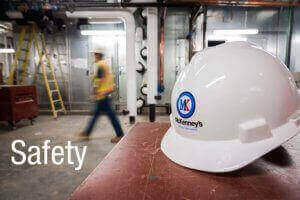By Charles Tinsley
 Most buildings’ control systems utilize Direct Digital Control (DDC) technology to manage the output and actions of HVAC systems, especially in the commercial market. However, for the industrial market and other mission-critical facilities, Programmable Logic Controllers (PLC) are often a better, faster and more reliable option that should be considered.
Most buildings’ control systems utilize Direct Digital Control (DDC) technology to manage the output and actions of HVAC systems, especially in the commercial market. However, for the industrial market and other mission-critical facilities, Programmable Logic Controllers (PLC) are often a better, faster and more reliable option that should be considered.
Although PLC and DDC controls both use sensor data to make decisions and write outputs, PLCs provide a level of sophistication specifically tailored for mission-critical environments that DDCs can’t always deliver. Check out the chart below for a side-by-side comparison.
| |
Hardware |
Software |
Contractor |
| PLC |
- Higher cost
- Battle-tested, extensive evaluation periods
- Manufacturers have higher barriers to entry because of the lengthy testing and evaluation required
- Slower to innovate and evolve because of the expensive evaluation process
- Longer expected life
- Fewer failures
- Redundancy can be built in more easily:
- Dual processors
- Dual power supplies
- More fault tolerant
- More safety features
|
- More universal ladder logic used, making serviceability across contractors easier
- Better process monitoring available
- Fast processing power
- Fewer software updates and patches required
- More safety features
- Less likely to be proprietary and instead utilizes open-source tools
|
- Higher cost
- Highly specialized integrator experts in certain industrial processes
- Typically longer mobilization lead times
- More prefabrication and preprogramming involved in execution as opposed to on the jobsite
- Potentially faster startup and commissioning durations
|
| DDC |
- Lower cost
- Failures more likely to occur but not necessarily imminent
- Rapidly evolving and innovating due to lower barriers to entry in market
- Redundancy can be built but is much more difficult to execute:
- Single processor
- Single power supplies
- Redundancy is not typically built into the network frameworks
- Not fault tolerant unless the design requires additional hardware and software be added
|
- Each product has its own programming language and makes multiple vendor service more difficult
- Sufficient processing power
- More software updates and patches required
- Fewer safety features
- More frequent product end-of-life periods
- Can be proprietary and have closed distribution models.
|
- Lower cost
- Contractors focus on the commercial market:
- Office buildings
- Hospitality
- Healthcare
- Institutional
- Shorter mobilization lead times
- Field programming and tinkering required, typically minimal prefabrication
- Potentially longer startup and commissioning durations
|
Have a question for our experts? Leave your comment below and check out our website for more information.
 Most buildings’ control systems utilize Direct Digital Control (DDC) technology to manage the output and actions of HVAC systems, especially in the commercial market. However, for the industrial market and other mission-critical facilities, Programmable Logic Controllers (PLC) are often a better, faster and more reliable option that should be considered.
Most buildings’ control systems utilize Direct Digital Control (DDC) technology to manage the output and actions of HVAC systems, especially in the commercial market. However, for the industrial market and other mission-critical facilities, Programmable Logic Controllers (PLC) are often a better, faster and more reliable option that should be considered.





